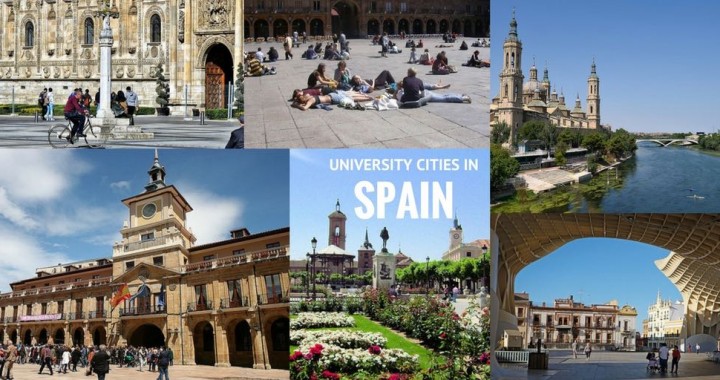Looking for university cities in Spain with a real buzz and character plus a sense of history? Or perhaps you want to find an interesting place to study Spanish? Here at Totally Spain, we’ve been designing travel itineraries since the year 2000 for solo travellers, families and special interest groups to these inspiring and enjoyable university cities in Spain. Here is our list of Top 10 University Cities in Spain and why we rate them so highly.
Top 10 University Cities in Spain
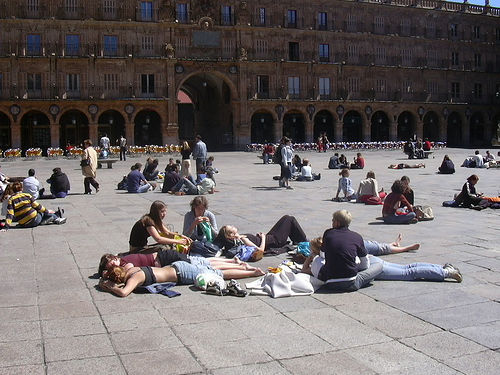
Salamanca’s stunning Plaza Mayor is the meeting place for students, academics and visitors to this charming university town. photo credit: Jcl Sunbathing in Salamanca via photopin (license)
1 Salamanca –the UNESCO-listed city with Spain’s Best Plaza
Ask any Spaniard to name their favourite university city, Salamanca will always top the list and not just because it is the oldest university in the country. It’s also a place the Spanish hold fondly in their hearts, regarding it as on a par with Oxford and Cambridge for its beauty and atmosphere. The university was founded back in 1218 and today is home to 31,000 students and another 4,000 language students a year. It was the first Spanish university to offer language courses to foreign students when it inaugurated its Spanish language program in 1929 and if the number of nationalities you see in the city are a gauge, the demand for language courses is ever on the increase. University alumni include Don Quixote author Miguel de Cervantes and Spanish conquistador Hernán Cortés. You may not have heard of the second university in the city – the privately-run Pontificio University, that brings in an additional 6,500 students to the city.
To Get There
Travel 90 mins by train or 2.5 hours by car northwest of Madrid
What to Do in Salamanca
- Find the frog carving in the university façade ( it’ll make sense when you get there!)
- Visit the old university stables which is now an atmospheric cafe called the Caballerizas.
- Visit the UNESCO-listed 12th and 16th century cathedrals that sit side-by-side
- Climb the Clerecia towers – the views from the Jesuits’ bell towers are incredible!
- Be amazed at the beauty of the House of Shells.
- Walk over the Roman bridge – beautiful by day and by night.
- Spend some time in the Plaza Mayor from the 18th century which we regard as one of Spain’s most dazzling squares.
- Pop into to the Convento of San Esteban – much admired for its Plateresque and Baroque decoration. Ask about its former lodger Christopher Colombus.
- Sample the delicious local Iberico hams.
- Taste the ‘hornazo’ – a traditional savoury pie from here that’s eaten in abundance on the Monday after Easter.
- Keep an eye out for the many ‘tunas’ which are university students dressed in traditional costume that busk in bars, restaurants and any social events.
- Pick up some of the sweet almond pastries at the Convento de las Duenas shop.
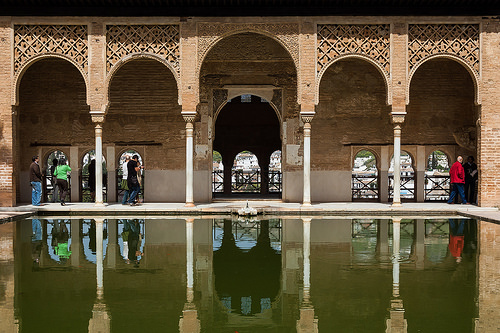
Whether you’re a student at the university or a visitor to the UNESCO-listed Alhambra, the city of Granada gives you more than you can hope for! photo credit: Vallausa Granada 047 via photopin (license)
2 Granada – Free Tapas & the UNESCO-listed Alhambra
Founded in 1531 by Emperor Charles V but with links back to the Nasrid Kingdom, the University of Granada (UGR) caters for 56,000 students and a further 10,000 overseas language students annually. It might sound like a lot but it’s only a drop in the ocean when you consider that 2.8m visitors spent a night or more in Granada during 2016. Most of them came to see the Alhambra and if you come to Granada, you’ll want to do the same.
To Get There
Granada is a 4-hour drive from Madrid by car and an hour longer by train or bus. It’s much closer to Malaga – which is just 2 hours by bus.
What to Do in Granada
- The Alhambra is the must-see in Granada, attracting a whopping 2.5 million visitors every year. We recommend you pre-book tickets or pre-book a tour guide for the Alhambra and the Generalife gardens. Read more about pre-booking tickets for attractions in Spain and the benefits of a private guide/driver.
- Visit the Albaicin neighbourhood (also UNESCO-listed) which is the largest still-inhabited Moorish quarter in Spain and the original site of an ancient Roman settlement.
- Eat at one of the stunning ‘carmens’ or villas where you are also rewarded with some pretty special views of the Alhambra.
- Relax over a refreshing wine or beer and complimentary tapas in the city’s great bars and restaurants. We can recommend tapas bars and tapas tours for you.
- Visit the city’s cathedral where King Ferdinand and Queen Isabella, the Catholic monarchs are laid to rest. Work began on the cathedral in the early 1500’s but it wasn’t completed until 1702!
- Dine on a pleasant Moroccan meal in the narrow cobblestoned Albaicin neighbourhood of the city which not only enjoys great views of the Alhambra; its layout harks back to the city’s Medieval Moorish past.
- Take a tour of the Realejo neighbourhood also known as the Juderia or Jewish Quarter during the Muslim period of rule and visit the Sephardi Museum of Granada and the Palace of the Forgotten. You can read more about Granada and Spain’s Jewish heritage here.
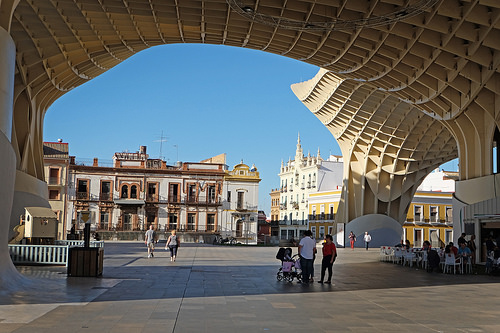
Modern meets traditional in Seville’s city centre where you seem to elbow up to camera crews and actors as often as academics! photo credit: Nicatli Sevilla – Las Setas via photopin (license)
3 Seville – Set for Game of Thrones, Star Wars & More
62,000 students call this city home during term time and what a home to have! Seville is the most romantic of the Spanish cities – where else will you wake up to the scent of orange blossom and sound of horse-drawn carriages in the park? Established by the Catholic royalty back in 1505 under the name Colegio Santa María de Jesús, today the campus is still in the city centre next to the Maria Luisa Park which is one of the life-lines in the city during the warmer months of the year.
To Get There
Seville has an international airport and is also connected to Barcelona and Madrid by air, bus and the AVE high-speed train network.
What to Do in Seville
- Visit the Royal Tobacco Factory – the inspiration for Bizet’s Carmen, which is now the head office for Seville University. Explore the Barrio Santa Cruz which was the old Jewish quarter in Seville. (Read about Barrio Santa Cruz and Jewish Spain here)
- Take a tour of the UNESCO-listed Seville Cathedral. Built on the site of a former mosque, it’s the largest Gothic cathedral in the world and is the burial site of Christopher Colombus who docked here on his return from the Americas and put this city on the international trading map. Make sure to climb the Giralda bell tower where the views of the city are wonderful and as you exit, visit the Patio de los Naranjos (the Orange Courtyard).
- When the day begins to warm up, pop into the 9th century Alcazar which is the oldest active royal palace and gardens – a real must-see in Seville. Recently the Game of Thrones series has been filmed here – Seville is no stranger to the camera. (We written about Seville’s Alcazar and Spain’s other amazing castles and alcazars here)
- Explore Seville’s best known park – the Maria Luisa – to the beautiful Plaza de Espana – another ‘must-see’ here in Seville especially to Star Wars and Lawrence of Arabia fans. We’ve written about this location and other famous Spanish movie and TV locations here.
- Fans of modern architecture will enjoy walking around and on top of the Metropol or ‘Las Setas’ meaning mushrooms (pictured above)
- Shoppers should explore Calle Sierpes for traditional Spanish items such as fans, ceramics and leather goods. Anybody with a little girl in their life should shop for a feria-inspired flamenco dress or the flamenco shoes and castanets.
- Take in a live flamenco show.
- Join a food tour to learn about the city’s eateries and taste some typical tapas and wines.
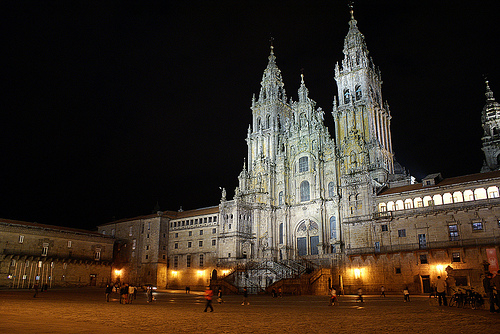
Santiago’s best known square – beloved by pilgrims and residents alike! photo credit: A ferro El Obradoiro via photopin (license)
4 Santiago de Compostela – Pilgrims & Scholars
Founded in 1495, this institution of 30,000 students is located in the centre of this city that is also well-known for the Camino de Santiago pilgrimage that finishes here at the cathedral. You’ll find the city buzzing with both students and pilgrims – both celebrating their good luck at having chosen this elegant city to begin or end their journey! Are you tempted to travel here?
To Get There
Santiago is connected by air to many Spanish cities and a number of other European cities including London, Dublin, Rome, Geneva, Brussels, Amsterdam, Munich and Frankfurt.
What to Do in Santiago
- Take a guided tour of Colegio Fonseca – especially the gardens and the library.
- Visit the cathedral. The granite-faced Romanesque structure dates from 1075 but it’s the later add-ons such as the Baroque façade on Obradoiro Square that most of us associate with this cathedral. Take a rooftop tour of the cathedral and try to catch the botafumeiro – the thurible that swings incense through the cathedral at high speed.
- Walk around the Abastos food market and marvel at the fish counters!
- Explore the granite-dominated old quarter of Santiago which is completely pedestrianised with charming galleries and archways.
- Visit the Parador – Hostal dos Reis Catolicos – which is in Obradoiro Square. There’s a lovely outdoor cafe restaurant with lovely views of the cathedral. It’s courtyard garden is also beautiful. It’s very easy to spend a day or more soaking up the atmosphere in Santiago. (If you’d like read about more paradors, we’ve selected our favourites here)
- Eat octopus and any other type of seafood you can manage with a glass of albarino. Scallops known as vieiras are the symbol of the Camino so you might want to keep one of the shells as a keepsake.
- Try the tarta de Santiago – an almond tart prized locally
- If you have a few free days, consider walking the last 100km of the Camino. Read about the Camino de Santiago here.
- Explore the rest of Galicia – we’ve written about some of our travels to palaces, beaches and wineries here.
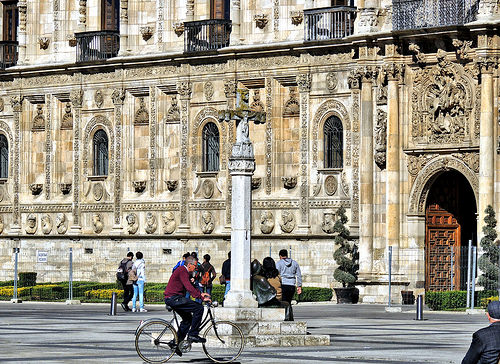
What was once a convent in Leon is now a luxury Parador hotel but even if you’re on a student budget, you can still go inside to the bar and get a sense of the place from the inside! photo credit: jl.cernadas 4401-Hostal San Marcos en Leon. via photopin (license)
5 Leon – Free Tapas & Gaudi
The University of Leon dates back to 1979 when it formally separated itself from the University of Oviedo. Although the university doesn’t rank as highly as some of the other colleges in this list, when it comes to a party atmosphere, this city (and its student population of 14,000) doesn’t disappoint! You’ll want to join in the fun in its wonderful old quarter which comes alive at lunchtime and tapas time in the evening. Don’t be surprised if you never manage a sit-down meal – the free tapas are more than enough to keep you going all day long.
To Get There
Although it’s connected by air to Madrid and Barcelona, most people arrive by car or bus (3 hours)
What to Do in Leon
- Visit the 13th century Gothic cathedral and gaze at the detail in the 1,800 square metres of stained glass.
- Visit San Isidore’s Romanesque basilica and museum which gives you access to the royal pantheon and you can view the goblet of Infanta Doña Urraca, said to be the cup from which Jesus Christ sipped and served communion at the Last Supper.
- Explore the former 16th monastery – now a Parador and church of San Marcos
- Take a tour of Casa Botines – a newly opened museum in one of the few Gaudi-designed buildings outside of Catalonia. (If you’d like to see more of Gaudi’s work, check our post on his architecture in Barcelona here.)
- Stroll around its wonderful squares – especially the 17th century Plaza Mayor, the Plaza de San Marcos and Plaza de Regla
- Explore the tapas bars of the Barrio Humedo and order cecina de Leon (a cured meat) and morcilla de Leon (blood pudding)
- Hike or drive some of the Camino de Santiago which passes through Leon. We have written about suggested driving routes here.
- Arrange a winery visit in the nearby El Bierzo winery region

Eye-boggling no matter what your discipline is! Calatrava’s City of Arts and Sciences has to be seen to be believed! photo credit: kuhnmi City of Arts and Sciences by Night via photopin (license)
6 Valencia – Architecture & Beaches
Not one, not two, but three universities make Valencia one of Spain’s most enjoyable university cities. The old institution is the University of Valencia which was founded in 1499 and has 50,000 students enrolled on its books today. Next was the Polytechnic University of Valencia (UPV) which opened in 1968 and now has a headcount of 40,000 students. And finally, the Catholic University of Valencia which was founded in 2003 brings in another 13,500 students to this modern Mediterranean city, that is buzzing with creativity, atmosphere and outdoor activities.
To Get There
You can fly into Valencia from dozens of Spanish and European cities. Want to come by train? The AVE high-speed train connects Valencia to Madrid in 1hr45 mins and Barcelona in 3hr10 mins.
What to Do in Valencia
- Visit the wild and wonderful City of Arts and Sciences designed by home-grown ‘starchitect’ Santiago Calatrava. The building itself is a gift to photographers and fans of sci-fi and if you have kids with you, they’ll enjoy the shows and exhibits inside the Oceanografic museum and Science museum.
- Visit the extravagant Art Nouveau building from 1914 that is the Central Market which is still a thriving marketplace today and the Modernista-styled Colon Market also from 1914 which was a fresh food market but it now more like a shopping mall.
- Learn about the importance of silk to the city at the 15th century Silk Exchange.
- Taste horchata – a refreshing almond-like drink made from a root called the tiger nut.
- Order a paella. If you’d like we can arrange for a paella cooking class. Tapas tours are also well worth taking. (See why we recommend food tours here)
- Stroll around Turia Gardens – created when the river was diverted away from the city centre following the catastrophic flooding in 1957.
- Visit the IVAM – a museum that takes a look at the 20th century art movements including Popart and Abstract.
- If you are in town from 15-19 March – prepare yourself for the party of all parties – Las Fallas – where giant figures made from paper, wax, wood and Styrofoam are burned ceremoniously. A year’s work of labour goes up in smoke every year with the exception being the winning ‘ninot’ which is spared and sent to the Fallas Museum – which is where you should go – if you aren’t in Valencia in March.
- Walk around the El Carmen which is great for traditional tapas and head to Ruzafa for more contemporary eateries and hip bars.
- Go to the beach! You have Arenas and Malvarrosa beaches within walking distance of the city and further out you have dozens of great options.
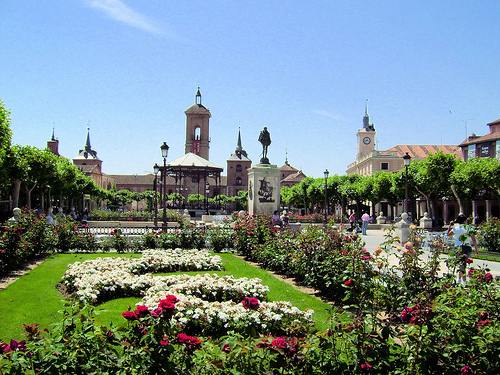
The square dedicated to Cervantes in his place of birth – Alcala de Henares. photo credit: Daniel Rocal Plaza de Cervantes via photopin (license)
7 Alcala de Henares – Storks & Cervantes
1293 is the date we have for this city’s debut as a centre for learning. Alcala de Henares’s academic reputation was given a huge boost by Cardinal Cisneros’ support in 1499 which enabled it to became the world’s first university city. Today, its student population of 28,000 enjoys the charming UNESCO-listed surroundings – and so will you – if you find yourself in this wonderful university city closeby Madrid.
To Get There
Alcala is just 35 mins by car or suburban train from Madrid and 20 mins by taxi to Madrid airport.
What to Do in Alcala
- Alcala University was founded by Cardinal Cisneros back in 1499 and you should visit a few of the university buildings here. Start out with a tour of the Colegio Mayor de San Ildefonso – the plateresque masterpiece dating from 1537. Visit the Paraninfo building where the Cervantes Prize for Literature is awarded every April.
- Keep an eye out for the many storks and their nests on the nearby towers and steeples!
- The writer of Don Quixote and Sancho Panza was born here in Alcala in 1547. Cervantes’ birthplace on Calle Mayor is now a museum and is worth visiting to learn more about the man who created Don Quixote and Sancho Panza.
- Enjoy strolling along Calle Mayor – with its stunning baroque arcades supported by pillars. It is said to be the longest street of its type in Europe.
- Look out for the Corral de Comedias theatre in Cervantes Square that dates back to 1601 (although it has been altered significantly since it was established).
- If you want to dine in luxurious yet academic surroundings, the 17th century San Jeronimo College is now a Parador and offers all the local specialities including roast meats and great wines. The Parador also runs Cervantes-themed culinary events from time to time.
- Take a daytrip into Madrid. You might see some curious looking characters on the platform as there a Cervantes train running this line from time to time with actors dresses up in period costume as Don Quixote, Sancho Panza and Dulcinea among others.
- Have a look at other great day trips near Madrid worth exploring.
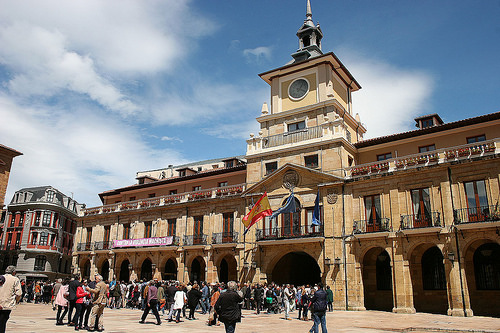
The ochre-toned streets of Oviedo – a joy to explore for an academic year or just a few days! photo credit: Gonmi Ayuntamiento de Oviedo via photopin (license)
8 Oviedo – Blue Cheese & Cider
Founded in 1608 by Fernando de Valdés, Archbishop of Seville, the golden-hued city of Oviedo is capital of the Principality of Asturias with its fiercely proud history. If you haven’t heard about it, perhaps you saw it in all its glory in the Woody Allen movie ‘Vicky Cristina Barcelona’ – when the artist played by Javier Bardem whisked Scarlett Johansson and her friend away there for a weekend. It looks great on the screen but is even better in real life and certainly deserves to be one of the Top 10 University Cities in Spain. Why not visit in person and see why 24,500 students make this city their home every year?
To Get There
Direct flights from Barcelona, Madrid, Munich, Paris, Lisbon and London go to Asturias airport which is 30 mins by taxi from Oviedo. You can also travel by rail and bus from Madrid to Oviedo which takes 4-5 hours.
What to Do in Oviedo
- Visit the Gothic cathedral well-known for its number of relics
- Taste the cider in a sidreria along Calle Gascona – notice how you’ll need to pour the drink (or have it poured for you) from a height to add some natural fizz into the glass. (You can read more about cider-pouring and other gastronomy skills in Spain here)
- Try the extremely strong blue Cabrales cheese – on its own, or melted over a steak. (We’ve written about Spain’s great cheeses here.)
- Walk to the UNESCO listed Santa Maria del Naranco (45 mins walk or 10 mins in a taxi) to see the pre-Romanesque gem and enjoy the views over Oviedo
- Try a cachopo (breaded steak) at Las Tablas del Campillín, winner of the Asturian Cachopo Competition in 2016. Have your camera at the ready and make sure you are good and hungry!
- Taste the white bean stew called fabada – another dish you’ll need to be hungry for.
- See the Woody Allen statue in honour of the director who said of this city: “Oviedo is a delicious, exotic, beautiful, clean, pleasant, tranquil and pedestrianised city. It is as if it did not belong to this world, as if it did not exist … Oviedo is like a fairy-tale.”
- Catch the local bagpipe players in action. The bagpipe is called ‘gaita’ here and you’ll find a band of bagpiper players at official and family events in the region of Asturias.
- Walk or drive a section of the Camino Primitivo which starts in Oviedo – you can read more about the Primitivo route (and others) here.
- Visit the many fishing villages such as Cudillero – see our post on the coastline here.
- Make a daytrip into Picos de Europa National Park
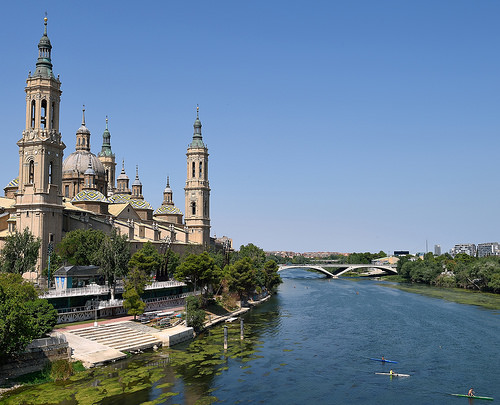
Zaragoza – home to a university, many works of Goya and the remarkable Basilica de Nuestra Señora del Pilar. photo credit: transitpeople Basílica de Nuestra Señora del Pilar in Zaragoza, Spain via photopin (license)
9 Zaragoza – Mudejar Architecture & Goya
The University of Zaragoza was founded in 1542 (although teaching only began in 1582!) on the site of a former school that itself dated back to the 12th century. That’s the same time that the many Mudejar creations – which are listed UNESCO structures today – were beginning to emerge as a result of the harmony between cultures in the city. Come visit Zaragoza today – where you’ll find 32,500 people studying at the university and living in this most unusual and interesting of cities in Spain.
To Get There
The AVE high-speed train takes just 1hr20mins from Madrid and 1hr 28 mins from Barcelona. If you wish to fly into Zaragoza from outside Spain, Ryanair flies direct from London, Brussels-Charleroi, Paris-Beauvais and Milan-Bergamo.
What to Do in Zaragoza
- Back in the 11th century, the Palacio de la Aljaferia started out life as an Islamic royal palace and today is home to the Aragon Regional Parliament. One of the city’s best loved examples of Mudejar architecture, pay special attention to its towers, roof, ceilings and plasterwork when you visit the palace.
- The site for the Seo de Salvador Cathedral has been used as a place for worship as far back as the first century BC. The current structure was built in the 12th century and features a range of styles including gothic, Mudejar, Renaissance and Baroque. You can also visit the Tapestry Museum inside the cathedral.
- Goya was born in the region of Aragon and moved to Zaragoza in 1749 aged just 3. You can see his statue in front of the Seo Cathedral and find his handiwork in the Museum of Zaragoza, the Basilica of Our Lady of Pilar, the Camon Aznar Museum and the Diocesan Museum of Zaragoza.
- Luis Bunuel, film director was also from Zaragoza and you’ll find a school, a park and a street named in his honour here.
- The modernist architecture is stunning in Zaragoza – especially Casa Solans and the old Patria Biscuit Factory. You find a suggested walking tour here.
- If you’ve ever been a fan of origami, the EMOZ museum dedicated to just is worth a visit.
- Enjoy the views of the city from the top of the Basilica de Nuestra Senora de Pilar!
- Explore the streets around El Tubo and La Magdalena for tapas bars.
- Taste local specialties such as truffles, dried tomatoes, saffron and meats – especially lamb which is known as tarnasco. Wash it down with local Somontano wines and Ambar beer.
- The city is at its busiest during the Fiestas del Pilar – the patron saint of Zaragoza – on the 12th October. If you are there, prepare yourself for a big party.
- Zaragoza was host to the 2008 Expo and you’ll still find lots of elements still in the city from that event including the bridge designed by Zaha Hadid known as the Pabellon Puente.
- Explore the Somontano Wineries nearby
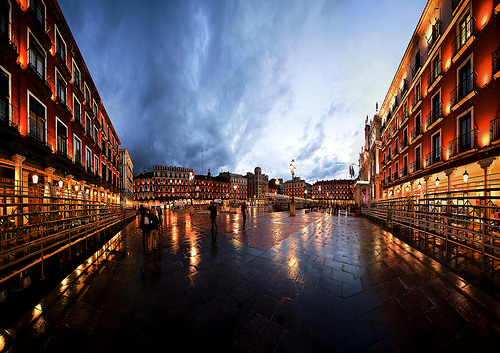
Sunset in the wonderful Plaza Mayor in Valladolid! photo credit: Chema Concellon Embudo via photopin (license)
10 Valladolid – Churches, Processions and Wines
According to documents signed by King Sancho IV of Castile, the University of Valladolid was founded in 1293 and for centuries was a leading centre for education alongside its neighbour in Salamanca and Alcala de Henares. You can feel its past as you walk through the squares, museums and churches. But it’s also a modern city and a very elegant one which attracts 25,000 students (dispersed across the four campuses at Valladolid, Palencia, Segovia and Soria).
To Get There
Valladolid is just one hour from Madrid by high-speed train.
What to Do in Valladolid
- Listen to the Spanish. Spain’s best Spanish is said to be spoken here.
- Visit the National Sculpture Museum – to explore its collection of sculpture and art from the late-middle ages to the 1800s and enjoy the building itself.
- Order tapas in the many bars and restaurants that surround the Plaza Mayor
- Visit the Old Royal Place – home of the royal family when Valladolid hosted the Royal Court from 1601 to 1606. It was also the birthplace of King Philip IV of Spain
- Have some pastries at Cubero beside the Plaza Mayor on Calle Pasión, 7– and visit its Museo del Dulce upstairs to see the reproductions of local landmarks in crystallised sugar. The torrija here is absolutely wonderful – especially after a long day of sightseeing.
- Visit the beautiful cast-iron Mercado del Val from 1878 which is not only a food market but also houses a number of bars and cafes.
- Sit in the Plaza Mayor that dates from 1561.
- If you can read Spanish, pick up a copy of one of Miguel Delibes’s books and read it on one of the benches. Delibes was born here and lectured in the city – and is one of Spain’s best regarded writers of the 20th century – learn more about his legacy at the Miguel Delibes Foundation.
- Experience the Easter processions which are among the more solemn in Spain. The scale of the processions is impressive and while crowded, it’s still possible to experience the ‘pasos’ up close. (You can read about the Easter celebrations here and throughout Spain here).
- Visit the College of Santa Cruz. Its façade is the earliest Renaissance work made in Spain. Founded by Cardinal Mendoza in the 15th century, the building has a courtyard with three floors of arcades with semi-circular arches, a library and chapel. Today, it’s a university residence attached to the University of Valladolid.
- Take a wine tasting at a wine-bar in the city or if you have time, visit some of the world-famous Ribera del Duero wineries nearby.
- Still have some time? Visit some of the amazing castles nearby.
